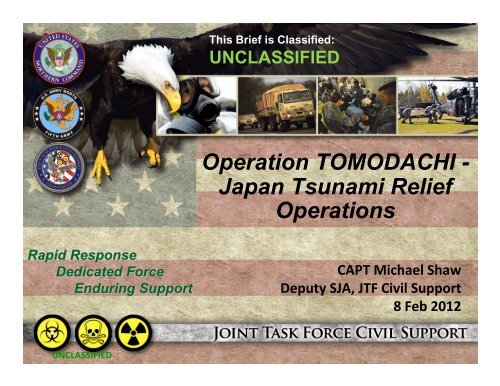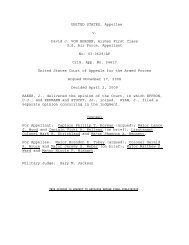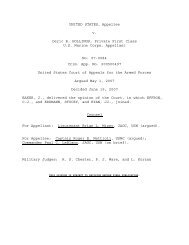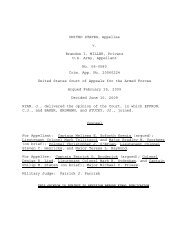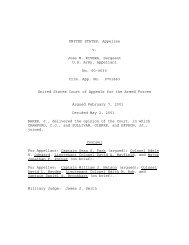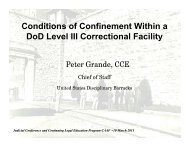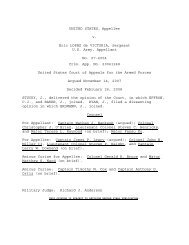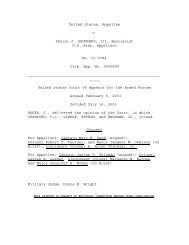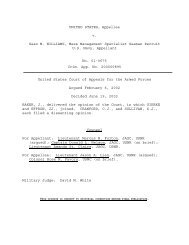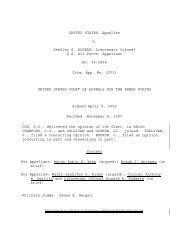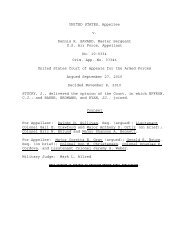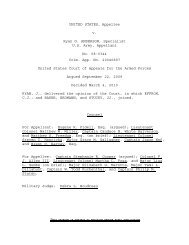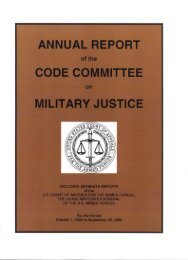Operation TOMODACHI - Japan Tsunami Relief Operations
Operation TOMODACHI - Japan Tsunami Relief Operations
Operation TOMODACHI - Japan Tsunami Relief Operations
Create successful ePaper yourself
Turn your PDF publications into a flip-book with our unique Google optimized e-Paper software.
This Brief is Classified:<br />
UNCLASSIFIED<br />
<strong>Operation</strong> <strong>TOMODACHI</strong> -<br />
<strong>Japan</strong> <strong>Tsunami</strong> <strong>Relief</strong><br />
<strong>Operation</strong>s<br />
Rapid Response<br />
Dedicated Force<br />
Enduring Support<br />
CAPT Michael Shaw<br />
Deputy SJA, JTF Civil Support<br />
8 Feb 2012<br />
UNCLASSIFIED
CAPT Shaw’s Spring Break<br />
2011
RUN if you see CAPT Shaw headed<br />
your way during your Spring Break
More reasons to RUN<br />
• Every base, post or station where I’ve ever<br />
been stationed has shuttered<br />
• My legal career involves showing up at<br />
catastrophic incidents<br />
– Cavalese (‘98)<br />
– Indonesia tsunami (‘05)<br />
– Somali pirates (‘10)<br />
– <strong>TOMODACHI</strong> (‘11)<br />
– JTF-CS (‘01 – present)
Geographic Orientation<br />
Sendai<br />
Misawa AB<br />
Yokota AB, USFJ HQ<br />
MCAS Iwakuni<br />
CP Zama<br />
Epicenter ‐ 11 March<br />
Fukushima Nuclear<br />
Power Station<br />
Tokyo<br />
NAF Atsugi<br />
CFA Yokosuka<br />
CFA Saseba<br />
5
Sendai Airport<br />
5
Sendai Airport<br />
5
Fukushima Daiichi
USFJ/5AF SJA Office
JSF OSJA
• USFJ is a PACOM sub-unified command HQ’d at<br />
Yokota AB<br />
– USAF 3 Star Commander (Lt Gen Field)<br />
– Dual-hatted as 5AF CC<br />
– Col Zeb Pischnotte, USAF, SJA<br />
• ADM Willard, PACOM Commander transitioned<br />
USFJ to JSF <strong>Japan</strong> (JTF 519)<br />
– USN 4 Star PACFLT Commander (ADM Walsh)<br />
– CAPT Stu Belt, USN, SJA<br />
• Joint Support Force <strong>Japan</strong> was the operational HQ<br />
for Foreign Consequence Management (FCM)<br />
• III MEF designated JTF-505 for Voluntary Departure<br />
• 3D MARDIV designated JFLCC for HA/DR
JJS coord thru BCAT-Ichigaya<br />
Joint Support Force C2<br />
PACOM<br />
JTF 505<br />
JSF<br />
T‐JFACC<br />
ADC coord thru BACCE<br />
Commander<br />
USFJ<br />
Deputy<br />
JSF<br />
USAFJ<br />
USARJ<br />
CNFJ<br />
MARFORJ<br />
ASO<br />
COCOM<br />
GSO<br />
thru<br />
BGCC<br />
MSO<br />
GSO<br />
JFLCC<br />
JFMCC<br />
JFACC<br />
JFSOCC<br />
OPCON<br />
TACON<br />
Direct Support<br />
Coordination<br />
CMTF<br />
JFLCC coord<br />
thru BCAT-Sendai
LINES OF OPERATION (LOO)<br />
Humanitarian<br />
Assistance/<br />
Disaster <strong>Relief</strong><br />
Foreign<br />
Consequence<br />
Management<br />
Authorized<br />
Voluntary<br />
Departure<br />
Lines of <strong>Operation</strong><br />
1.Distribution of HA/DR Supplies.<br />
2.Emergency medical relief and services.<br />
3.Force Protection (CBRNE).<br />
4.Critical Equipment and Engineering support.<br />
5.Sustainment support to the forces.<br />
1.Conduct radiological survey and reconnaissance.<br />
2.Mitigate spread of contamination of US forces.<br />
3.Optimize Exclusion <strong>Operation</strong>s.<br />
4.Provide Immediate medical assistance to US personnel.<br />
5.Gather and disseminate survey Hazard data.<br />
6.Conduct equipment and mass casualty decontamination.<br />
1.Coordinate the departure of US military family members.<br />
2.Prepare USFJ bases to support voluntary departure.<br />
<strong>Operation</strong> PACIFIC PASSAGE<br />
GoJ Support and Coord<br />
Protection<br />
Interagency Coordination<br />
Messaging<br />
LOO Objectives<br />
• Human suffering<br />
minimized<br />
• Crisis situation<br />
stabilized<br />
• GoJ and NGOs capable<br />
of sustaining operations<br />
•Effects of agents are mitigated<br />
•GoJ CM operations can be sustained<br />
with reduced DOD support<br />
•GoJ civil authorities postured to<br />
transition to recovery Ops<br />
•GoJ has ability to accommodate surge<br />
requirements for casualty treatment &<br />
critical support<br />
• Orderly transfer of US citizens<br />
to Safe Haven<br />
• Proper documentation of US<br />
SOFA personnel
<strong>Operation</strong> <strong>TOMODACHI</strong><br />
o 9.0 earthquake (4 th strongest worldwide since 1900)<br />
o 30+ foot tsunami<br />
o 433,000 square kilometers inundated (5 x size of<br />
Manhattan)<br />
o Nearly 500,000 evacuated<br />
o 70 miles of coastline submerged<br />
o Water reached inland 6 miles<br />
o 13,228 dead / 14,529 missing / 4,735 injured<br />
o 140,000 homes destroyed / damaged<br />
• US in support of <strong>Japan</strong><br />
• 1 st world country<br />
• wealthy country<br />
• highly developed technologically
Interesting Coincidences<br />
• Navy homeported USS George Washington (CVN-73)<br />
to Yokosuka in 2008<br />
– First nuclear powered vessel homeported there<br />
• Navy agreed to install and operate radiation<br />
monitors on Yokosuka and the surrounding areas<br />
• Naval Reactors (NR) had nuclear trained personnel<br />
in Yokosuka for this monitoring mission<br />
• NR is responsible for the safe and reliable<br />
operations of all Navy nuclear propulsion systems<br />
and reactors<br />
– NR prides itself on operating in the most demanding<br />
environments, to the most exacting standards and with no<br />
incidents
Interesting Coincidences<br />
• NR is mostly concerned about occupational effect of<br />
radiation<br />
– In confined spaces<br />
– Detecting and mitigating very low exposure rates over a sailor’s<br />
20+ year career<br />
• Understandably NR’s point of view and input carried<br />
great sway with decision-makers at all levels<br />
• BUT Fukushima releases covered the entire Kanto<br />
Plain and beyond<br />
– Environmental exposure<br />
– Houses and buildings shielded a good deal of radiation from<br />
residents<br />
– Brief exposure of a relatively short duration
Setting the Zones - GOJ
Setting the Zones – GOJ/DOD Disparities
Why did zone settings matter?<br />
• National level: Opens up discussion about why GOJ<br />
and USG have different zones<br />
– Does one gov’t know something the other doesn’t?<br />
– Does one gov’t know something it doesn’t want to say publically?<br />
– Appears to be disparate treatment of citizens<br />
• Theater level: PACOM ordered issuance of<br />
Potassium Iodine (KI) and monitor radiation<br />
exposure with dosimeters<br />
• Inside the DOD Warm Zones<br />
– Tokyo/US Embassy<br />
– Narita Airport<br />
– Hardy Barracks<br />
– New Sanno Hotel
Partial Catalyst for AVD<br />
• Yokosuka Navy Base is 200 south of Fukushima with Tokyo in<br />
between<br />
• Prevailing winds at Fukushima are from the west but on 15 March,<br />
slightly elevated radiation levels were recorded at Yokosuka<br />
– 1.5 millirems and then 20 millirems<br />
• Mammogram = 30 millirems<br />
• CT scan – 1,100 millirems<br />
• Residents were warned to stay inside<br />
– Letter<br />
– Email<br />
– Cones set up<br />
– Guards at the gates wearing surgical masks<br />
– Loudspeaker broadcast at NAF Atsugi<br />
• 17 March, Authorized Voluntary Departure by DOS (9,500 left)<br />
• 21 March, GW gets underway from Yokosuka
What did DOD Attorneys Do for AVD?<br />
• AVD involved spending $ quickly and<br />
entitlements so many fiscal law issues<br />
• DOD/DoS eventually expanded safehavens<br />
beyond US, requiring SecDef authority<br />
• Helped craft accurate public messaging for<br />
affected personnel and commanders<br />
• Focused on US personnel
Humanitarian Assistance/Disaster<br />
Assistance (HA/DR)<br />
• Civil assistance to a host nation (HN) following catastrophic<br />
event in the HN<br />
• 3D MARDIV (MajGen Brilakis) from Okinawa designated as<br />
JFLCC for HA/DR mission<br />
– All equipment and gear arrived from Okinawa and needed to get<br />
back to Okinawa when finished<br />
• Sendei is 80 miles north of Fukushima<br />
– Airport is a key transportation hub<br />
• About 500 Marines worked for 3 weeks to clear debris in Sendei<br />
• JFLCC radiation monitoring of equipment indicated elevated<br />
levels<br />
– HUMVEES and Sea Knight helicopters<br />
• Concern was that civilian government of Okinawa would bar<br />
returned to the island of equipment contaminated on Honshu
<strong>TOMODACHI</strong> (HA/DR) BY THE NUMBERS<br />
<strong>Relief</strong> Support Delivered by U.S. Forces<br />
Commodity DOD supplies GoJ, JSDF, NGO supplies<br />
Food 189 tons 57 tons<br />
Water 2.0 million gallons 112,536 gallons<br />
<strong>Relief</strong> Materials 87 tons 192 tons<br />
Forces/Equipment Component (Quantity) Total<br />
Personnel JSF HQ (918) JFLCC (685) JFACC (7,069) JFMCC (15,684) JFSOCC (182) 24,538<br />
Ships JFMCC (24) 24<br />
Aircraft JFLCC (12) JFACC (28) JFMCC (142) JFSOCC (7) 189<br />
Aircraft (sorties/flight hrs) JFLCC (827/1,356) JFACC (456/707) JFMCC (493/1,369) JFSOCC (161/245) 1,937/3,677<br />
ISR (sorties/flight hrs) Global Hawk (18/430) WC-135 (7/98) AMS (58/295) 83/823<br />
Vehicles JFLCC (39) JFACC (67) JFMCC (16) 122<br />
Over 28 days, more than 24,000 personnel, 24 ships, and 189 aircraft augmented<br />
<strong>Japan</strong>’s disaster relief efforts. 31
What did DOD Attorneys Do for<br />
HA/DR?<br />
• HA/DR involves expenditure of $ so many fiscal<br />
law issues<br />
• HA/DR operations were pretty straight forward<br />
and did not require a lot of legal advice<br />
• Focused on assisting GOJ and <strong>Japan</strong>ese Self<br />
Defense Force (JSDF) in response operations
Radiation Primer<br />
• Radioactive decay is the process by which an atomic nucleus<br />
of an unstable atom loses energy by emitting ionizing particles<br />
(ionizing radiation)<br />
• Release of radionuclides into the atmosphere from damaged<br />
reactors, either by water discharges/leaks or gas vapors<br />
– Iodine 131 (8 days)<br />
– Cesium 134 (2 years)<br />
– Cesium 137 (30 years)<br />
• Must distinguish between<br />
– Rate of exposure<br />
– Total dose exposure<br />
• For personnel, the greatest danger is inhalation & ingestion<br />
• For equipment and gear, radiation accumulates in collectors<br />
– Air filters<br />
– Leading edges of rotary blades<br />
– Dirt & dust in wheel wells of vehicles
How to measure radiation<br />
• Establish the background radiation level<br />
• Establish the radioactive level being emitted by the<br />
source<br />
• Subtract background from source reading<br />
• Solid surfaces<br />
– Radiacs, Geigers counters<br />
– Field labs<br />
• Liquids<br />
– Must undergo expensive lab tests<br />
– Few <strong>Japan</strong>ese labs and they were overwhelmed<br />
– Had to send outside <strong>Japan</strong>
Radiation Exposure<br />
Exposure Received (mRem)<br />
Average Background Radiation 0.071 NCRP Report No.160, 2009<br />
for 1 hour<br />
A single cross country flight 4<br />
New York to Tokyo polar flight 9<br />
route<br />
A single chest x-ray 10 Mettler, FA, et al, Effective<br />
Doses in Radiological and<br />
Diagnostic Medicine, 2008<br />
Average background radiation 620 NCRP Report No.160, 2009<br />
annually<br />
A single mammogram study 400 Mettler, FA<br />
A single CT scan 1,800 Mettler, FA<br />
Chernobyl evacuation zone 10,000<br />
Hiroshima survivor inside<br />
structure<br />
Nagasaki survivor inside<br />
structure<br />
78,000<br />
156,000
Radiation Primer<br />
• USS Ronald Reagan (CVN 76) and the GW were finding<br />
radiation but relatively easy to do a wash down at sea<br />
• As JFLCC surveys were finding elevated levels of radiation on<br />
helos and HUMVEES and HA/DR operations were winding<br />
down, the hourly chorus at JSF became<br />
WHEN IS CLEAN, CLEAN?<br />
Legally, the analysis of that question is<br />
1. What standard do you apply? USG? GOJ? International?<br />
DOD? If DOD, which service?<br />
– All US standards were significantly more restrictive than any<br />
GOJ standard<br />
2. Why did you choose the one you did? Required or policy<br />
decision?
What did DOD Attorneys Do for FCM<br />
<strong>Operation</strong>s?<br />
• Served on Joint Validation Review Board (JVRB) to<br />
vet materiel and services provided to GOJ<br />
– Unmanned helo from industry<br />
– Barges (2 x 250k gal)<br />
– Water pumps ($6M)<br />
– Google mapping service<br />
• Ensured appropriate use of Overseas Humanitarian<br />
Disaster Assistance and Civic Aid (OHDACA) funds<br />
– For host nation assistance<br />
– BUT a lot was being expended for DOD health force<br />
protection<br />
– Requires validation by DoS<br />
• BUT DoS Team left Embassy on 30 March
What did DOD Attorneys Do for FCM<br />
<strong>Operation</strong>s?<br />
• Identification of standards<br />
• Personnel Protection<br />
– Establishment of control limits<br />
– Establishment of zones<br />
• Decontamination Standards<br />
– Personnel<br />
– Equipment<br />
– Continued operations<br />
– Redeployment<br />
• Waste<br />
– DoD policy on LLRW<br />
– Exceptions<br />
– Responsibility for disposal<br />
– Host nation involvement
Decontamination of<br />
Personnel/Equipment<br />
• JFLCC (2nd MARDIV) was performing traditional HA/DR in<br />
Sendei, ~80 km north of Fukushima; equipment was<br />
contaminated<br />
• Ready to begin retrograding equipment back to Okinawa<br />
through Atsugi<br />
• Political concerns about OK government blocking retrograde of<br />
USMC equipment from Honshu to OK<br />
• Service have the TTPs to perform decontamination but lacked<br />
standards to determine when equipment could be retrograded<br />
off Honshu<br />
– FM 3-11.3/MCWP 3-37.2A/NTTP 3-11.25/AFTTP(I) 3-<br />
2.56/02FEB06, MULTISERVICE TACTICS, TECHNIQUES, AND<br />
PROCEDURES FOR CHEMICAL, BIOLOGICAL,<br />
RADIOLOGICAL, AND NUCLEAR CONTAMINATION<br />
AVOIDANCE
Decontamination of Personnel/Equipment<br />
• Always view radiation threat through occupational<br />
health lens<br />
• Must understand/appreciate difference between<br />
fixed and loose contamination as a health threat<br />
– Concern is inhalation threat to personnel engaged in decon ops<br />
• JSF J3 had a table choked with standards but no<br />
idea which one to choose<br />
• On 1 April in USFJ JOC, CAPT Fred Capria and<br />
CAPT Shaw cracked the nut
Decontamination of Personnel/Equipment<br />
• 011211Z Apr 11 - JOINT SUPPORT FORCE<br />
GUIDANCE FOR SCREENING AND<br />
DECONTAMINATION OF EQUIPMENT AND<br />
PERSONNEL OPERATING ISO OPERATION<br />
<strong>TOMODACHI</strong><br />
• Initial JSF msg dealt only with decontamination of<br />
personnel/equipment leaving Honshu<br />
• Directed components to capture and hold all<br />
decontamination process byproducts<br />
– Rags/wipes<br />
– Waste water
Decontamination of Personnel/Equipment<br />
• DoDI 6055.08, Occupational Ionizing Radiation<br />
Protection Program<br />
• “e. To the fullest extent practical, implement the<br />
safety and occupational health portions of<br />
Nuclear Regulatory Commission Regulation<br />
(NUREG)-1575, Revision 1 (Reference (o));<br />
NUREG-1575, Supplement 1 (Reference (p)); and<br />
NUREG-1576 (Reference (q)) when<br />
decontaminating or decommissioning<br />
installations, facilities, and equipment.”
Decontamination of Personnel/Equipment<br />
• NUREG-1575, Revision 1 – Multi-Agency Radiation Survey and<br />
Site Investigation Manual (MARSSIM)<br />
• NUREG-1575, Supplement 1 – Multi-Agency Radiation Survey<br />
and Assessment of Materials and Equipment Manual<br />
(MARSAME)<br />
– Appendix E. DISPOSITION CRITERIA - Disposition criteria<br />
specified by DOE regulations and orders are found in the Code<br />
of Federal Regulations, Title 10 (especially 10 CFR 835,<br />
Occupational Radiation Protection) and in applicable DOE<br />
Orders (especially DOE Order 5400.5, Radiation Protection of<br />
the Public and the Environment).<br />
• NUREG-1576 – Multi-Agency Radiological Laboratory<br />
Analytical Protocols Manual (MARLAP)
Table E.2 Figure IV-1, from DOE Order 5400.5, as Supplemented<br />
in November, 1995 Memorandum: Surface Activity Guidelines –<br />
Allowable Total Residual Surface Activity (dpm/100 cm 2 ) 1<br />
Radionuclides 2 Average 3,4 Maximum 4,5 Removable 4,6<br />
Group 4 - Beta-gamma<br />
emitters (radionuclides with<br />
decay modes other than alpha<br />
emission or spontaneous<br />
fission)<br />
except Sr-90 and others noted<br />
above 7 5,000 15,000 1,000<br />
6<br />
The amount of removable material per 100 cm 2 of surface area should be determined by wiping an area of that<br />
size with dry filter or soft absorbent paper, applying moderate pressure, and measuring the amount of<br />
radioactive material on the wiping with an appropriate instrument of known efficiency. When removable<br />
contamination on objects of surface area less than 100 cm 2 is determined, the activity per unit area should be<br />
based on the actual area and the entire surface should be wiped. It is not necessary to use wiping techniques to<br />
measure removable contamination levels if direct scan surveys indicate that the total residual surface<br />
contamination levels are within the limits for removable contamination.
Further use and refinement of the<br />
decontamination standard<br />
• Installations appropriated the standards for entry<br />
– Misawa used the standard at least 3 different ways in<br />
a 48 hour period for commercial vehicles that had<br />
traveled through Kanto Plain<br />
– Surveyed the vehicles for radiation levels then<br />
1. Refused entry to the vehicle<br />
2. Offloaded cargo onto a “clean” vehicle outside the gate<br />
3. Directed vehicle to wash down off installation then permitted entry<br />
– Attorneys then got engaged in reviewing/revising<br />
contracts<br />
• Aircraft were permitted to survey at the end of each<br />
day vice end of each sortie
Disposal of Low Level Radioactive<br />
Waste (LLRW)<br />
• DoD 4715.6-R requires all LLRW be disposed of through the<br />
DOD Executive Agent (Army – Rock Island, IL)<br />
– Approve waivers for disposal of LLRW outside the DoD program<br />
• Establishes the DoD LLRW Disposition Advisory Committee<br />
(LLRWDAC) to review performance and policy issues of the<br />
DoD LLRW disposal program<br />
• Historically, DoD In <strong>Japan</strong> has very little LLRW<br />
– Shipped to Korea for aggregation and trans-shipment to US<br />
• LLRWDAC began drafting a waiver to permit disposal of LLRW<br />
in waste streams of <strong>Japan</strong><br />
– Leave all LLRW in the hot zone<br />
– Maximize use of JSDF facilities<br />
– View as GOJ problem<br />
• DOD was doing no harm to the environment, certainly no worse<br />
than <strong>Japan</strong>ese
Disposal of Low Level Radioactive<br />
Waste (LLRW)<br />
• Dale Sonnenberg and CAPT Shaw drafted amendments to the<br />
<strong>Japan</strong>ese Environmental Governing Standards (JEGS)<br />
– USFJ decided NOT to proceed unilaterally<br />
• <strong>Japan</strong>ese attorneys found a <strong>Japan</strong>ese law that required TEPCO<br />
to receive and dispose of all radioactive waste<br />
• DOD is still working with GOJ to clarify TEPCO’s responsibility<br />
to receive LLRW waste<br />
– I-131 was untraceable within 45 days<br />
– DOD has disposed of liquid waste<br />
• Ed Bloom did the heavy lifting on liquid disposal<br />
• No nice neat equivalent to NUREG decontamination standard<br />
on disposal of radioactive contaminated liquids in US law or<br />
regulations<br />
– EPA regs are designed for nuclear power plants operators
The Way Ahead<br />
• The background radiation level for Honshu is<br />
elevated<br />
• DOD installations have established<br />
monitoring regimes for personnel and<br />
facilities<br />
• Some equipment has been permanently<br />
damaged beyond repair
The Way Ahead<br />
• 16 December 2011, USD(P) published Policy<br />
Memo – Radiological Clearance Criteria<br />
Guidelines for Platforms and Materiel<br />
• Rather than NUREG/DOE table, adopted<br />
American National Standards Institute<br />
/Health Physics Society (ANSI/HPS) N13.12-<br />
1999 (R2010), Surface and Volume<br />
Radioactivity Standards for Clearance<br />
– Increased levels beyond JSF levels<br />
• Allows for ease of clearance
The Way Ahead<br />
• USFJ has strengthened<br />
many GOJ ministerial level<br />
relationships<br />
• USG-GOJ alliance has been<br />
strengthened
An Enduring Alliance


